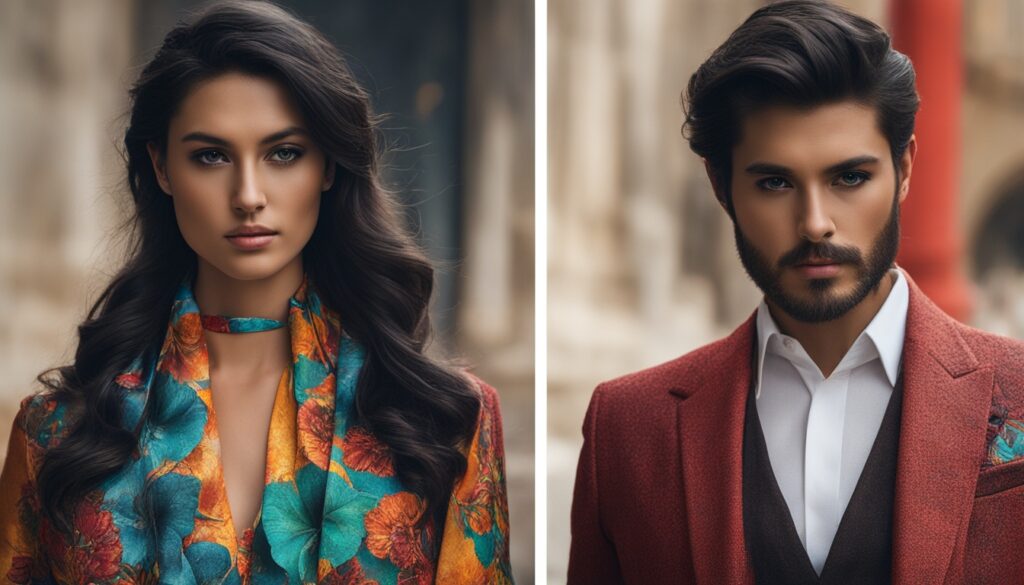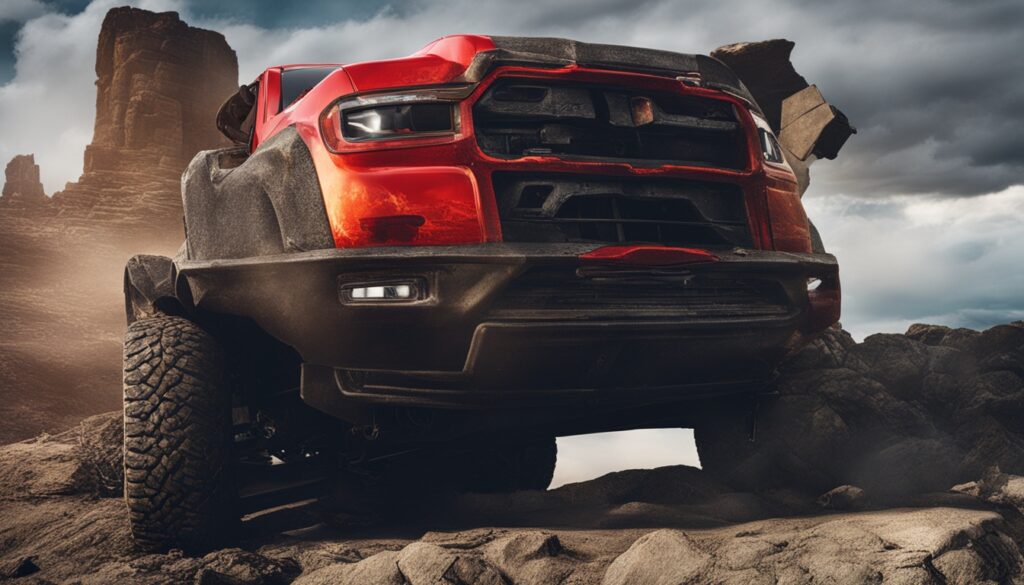DID you know DALL-E-3 creates images in two different styles? These are natural and vivid.1 It’s changing how we think about making pictures. This helps designers, marketers, and artists find new ways to create.
DALL-E is at the top in text-to-image synthesis.1 It is famous for making high-quality images from all sorts of topics. Now, with DALL-E-3, it’s even better. It brings new tools like prompt rewriting and setting image quality parameters.1
The change is in creating natural or vivid images.1 For example, the natural style is like DALL-E-2, with images that look real but not too exciting. The vivid style makes images pop out, almost like a movie. This choice gives more ways to be creative, meeting different needs, like AI art models.
Key Takeaways
- DALL-E-3 introduces two new image generation styles: natural and vivid.
- The natural style is more similar to DALL-E-2, while the vivid style leans towards hyper-real and dramatic visuals.
- DALL-E-3 offers adjustable quality parameters to control the level of detail and organization in generated images.
- The model supports three image sizes, affecting the style and context of the generated output.
- DALL-E-3 utilizes GPT-4 to optimize prompts for better results through its “prompt rewriting” feature.
Introduction to DALL-E’s Image Generation Capabilities
DALL-E is a model by OpenAI that turns words into pictures.2 It takes in detailed descriptions and makes real-looking images.2
Overview of DALL-E’s Text-to-Image Generation
The DALL-E API lets you make images from words.1 You can set how many images, their size, and style.1
It’s a great tool for anyone who wants to show ideas visually.3 For folks like writers, advertisers, and designers needing unique visuals.3
Importance of Visual Fidelity in AI-Generated Art
How real AI art looks is key.2 Realistic, sharp images catch eyes, helping in ads, art, or info.2
With better AI tech, creating art that looks real matters a lot.1 DALL-E tries to meet this with its features for lifelike images.1
Top-notch AI art can change how well it’s liked, trusted, and the feeling it gives.3 Really real images mix well with our own work, making creative work and real life mix better.3
Understanding DALL-E’s Vivid and Natural Modes
Defining the Vivid Mode
The vivid mode in DALL-E-3 makes images look super real.4 It uses bright colors and sharp details.4 This mode is great for ads, shows, or art that needs to be noticed.4
Choosing vivid mode means the pictures will be bold and sometimes look surreal.1 This approach is perfect for getting people’s attention.1
It even adds a touch of drama or high emotion, like on movie posters or in ads.3 Photorealism goes beyond with vivid mode. It almost feels like a scene from a movie.3
Defining the Natural Mode
The natural mode in DALL-E-3 is closer to real life than the vivid mode.4 It aims for images that are calm and real.4 Great for regular photos, product pics, and more.4
With natural mode on, pictures seem smoother and fit in easily.1 It’s used when you want photos to look very everyday.1
This mode creates images that seem humble but true, perfect for business or education.3 It’s for times when you want people to trust what they see, like in articles or at work.3
Key Differences Between the Two Modes
There are big differences between vivid and natural modes in DALL-E.4 Vivid mode makes bold, eye-catching pictures. Natural mode makes things look quiet and normal.4 Which one you pick changes how your image feels and the message it gives.4
Vivid mode stands out with its vivid colors and sharp edges, creating unreal or dreamlike images.1 Meanwhile, natural mode keeps things in check, making pictures that are familiar and calm.1
Vivid mode captures people’s eyes for things like ads and art.3 On the flip side, natural mode is better for blending photos into real settings.3

Evaluating Image Quality and Photorealism
Checking how real AI images look is really important. It helps us see if they fit different uses.5 We look at things like staying true to the original idea, the picture making sense, and how real it feels.6
Assessing Visual Fidelity in AI-Generated Images
DALL-E-3 is all about making images that make sense and look real.6 People want AI art to look natural. Modes like ‘natural’ and ‘vivid’ help do that. They make images that are exciting and real.
It’s key to think about small and big details in DALL-E’s images.7 Like, how accurate things are, lighting, and if it all looks real together. These points add up to how good the AI images seem.
Factors Influencing Image Quality
Lots of things affect how good DALL-E’s images are. This includes what the image is supposed to show and the data used to teach the model. Also the style chosen and the picture quality play a big part.5
DALL-E-3 gives more ways to make better images. For instance, you can pick how detailed or clear you want the picture to be.6 Changing these options really changes how the picture looks.
More stuff that matters includes how well the model turns words into clear images.7 How the pieces of the picture fit together, and how it deals with hard parts like different views, lighting, and making a nice picture.

DALL-E Vivid vs Natural: Exploring Image Generation Modes
DALL-E can make pictures that are vivid and natural. These two types look very different.4 The vivid style makes images that are bold and look like they’re from a movie. The natural style makes images that seem like they could really exist.4
Seeing vivid and natural images from DALL-E next to each other shows how unique each one is.1 Vivid images catch your eye and are great for certain uses. But, natural images fit in better in real life.1
Comparing Vivid and Natural Modes Through Examples
DALL-E’s examples in vivid and natural styles show the variety the model offers. These comparisons help people pick the best style for their needs. They also show how the choice affects the final image.
Analyzing Strengths and Weaknesses of Each Mode
Vivid images from DALL-E-3 are great for marketing or art because they stand out.4 However, too much detail might not be good for everything. Some projects need a more real look.4
Natural images are very real and come out clear. They’re good for things like pictures of products or showing buildings.1 They might not be as exciting as vivid images, but they fit real life well.1
Choosing between vivid and natural modes depends on what you want to create. Understanding their features helps you pick the right one. Think about how you’ll use the image to choose well.
User Preferences and Creative Applications
Surveying User Preferences for Vivid vs Natural Modes
More and more people are using DALL-E-3. It’s important to know if they like the vivid or natural modes better2. By doing surveys, developers and artists can learn which mode works best for certain jobs and who likes what. Some find vivid mode exciting, like a movie. Others enjoy the calm look of natural mode. What you’re making, who you are showing it to, and your own style all matter.
Studying what users say can help make DALL-E’s modes even better. This way, the tech can keep up with what creators, designers, and others want. They use AI art to improve their projects.
Creative Applications of DALL-E’s Image Generation Modes
DALL-E-3’s vivid and natural modes are good for many things. They work in ads, art, and showing off products2. Vivid mode stands out on posters and ads, while natural mode is better for showing off products and making diagrams2.
You can use both modes, depending on what you want to do. Vivid mode is great for emotional or dramatic looks. Natural mode helps pictures look real.
DALL-E’s modes let people get creative in many fields. With time, users will find new and cool ways to use AI images. This will revolutionize how they work on creative projects.
Model Training Data and Techniques
DALL-E creates images by using a huge, varied dataset. It includes many image-text pairs. This allows DALL-E to link what things look like with how they’re described.1
The dataset for DALL-E-3 has been meticulously selected. It aims for high accuracy and covers lots of topics and styles. This makes the images look real and interesting.8
Understanding DALL-E’s Training Data
Looking closely at DALL-E’s data shows what it can and can’t do. A big, diverse dataset is crucial for creating detailed, realistic images for many uses.9
Techniques Used for Improved Image Generation
DALL-E-3 not only has rich data but also uses advanced tech. It uses big language models, smart algorithms, and special network designs. These help it understand and create from text.1
One new feature in DALL-E-3 is prompt rewriting, powered by GPT-4. It makes prompts better for the model to understand. Also, methods like learning from various sources and improving images over time are part of developing DALL-E-3.89
Image Quality Metrics and Evaluation
Evaluating AI-generated images involves many measures. There are both objective and subjective ways to do this. Objective measures include SSIM, PSNR, and FID. They look at factors like how real and coherent the images are.8
Objective Metrics for Assessing Image Quality
Using these objective measures is great for checking DALL-E’s progress. It helps compare its vivid and natural modes. This approach gives objective insights into DALL-E’s strengths and areas to improve.8
But, these measures don’t cover everything. They miss the image’s emotional effect and use for specific needs. To fully understand AI’s image quality, we need to mix both types of evaluation.8
Subjective Evaluation of AI-Generated Art
Subjective feedback is key in understanding DALL-E’s art quality. It involves asking users and experts their opinions on the art’s merit and realism.8
This type of feedback shows how people view DALL-E’s images. It adds depth to the insights gained through objective measures, giving a clearer picture of the model’s abilities.8
FAQ
What is DALL-E and what are its image generation capabilities?
What are the “natural” and “vivid” generation styles in DALL-E-3?
How do the visual fidelity and photorealism of DALL-E’s generated images affect their effectiveness and acceptance?
What are the key differences between DALL-E’s vivid and natural generation modes?
How do user preferences and creative applications differ between DALL-E’s vivid and natural modes?
What factors influence the quality and fidelity of DALL-E’s generated images?
How can the quality and photorealism of DALL-E’s images be evaluated?
Source Links
- https://cookbook.openai.com/articles/what_is_new_with_dalle_3
- https://medium.com/@RLavigne42/comparing-dall-e-stable-diffusion-and-midjourney-prompt-engineering-2024-4bf19ac11256
- https://www.geeksforgeeks.org/what-is-dall-e/
- https://aqiltech.com/index.php/2024/04/30/dall-e-vivid-vs-natural/
- https://www.pickfu.com/blog/dall-e-vs-midjourney/
- https://blog.opengpt.com/2024/02/04/comparative-analysis-of-ai-image-generation-models-dall·e-3-google-imagen2-stable-diffusion-and-midjourney/
- https://theaitrack.com/ai-image-generator-crash-test/
- https://learn.microsoft.com/en-us/azure/ai-services/openai/how-to/dall-e
- https://medium.com/@seo.germany/dall-e-the-new-age-ai-image-generation-model-f505bf22577f

